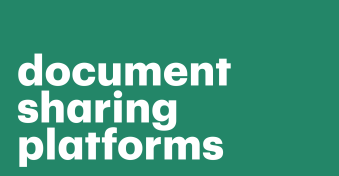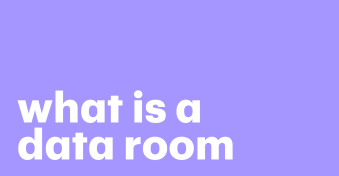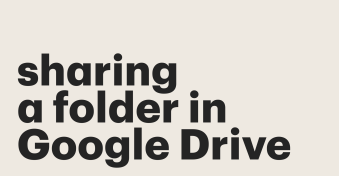No matter what business you’re in, the chances are you deal with important documents and files.
What, though, is the best way to store and share those with colleagues, clients, and stakeholders? Should you choose Dropbox or a data room?
We’re glad you asked.
What is Dropbox?
You may have heard the terms Dropbox and data room used interchangeably, but they have some key differences.
Dropbox essentially gives you access to a folder in the cloud that can sync with the folders on devices used by you and your team.
This makes it easy for you to pick up work from your laptop or your office desktop, and it lets you and your team work closely together on files without having to email them back and forth.
Sharing files is as easy as sending a link (no breaking the company intranet with large email attachments).
Dropbox integrations take even more work off you by syncing seamlessly with the other solutions in your tech stack (like PandaDoc).
What is a data room?
A data room (sometimes called a “Virtual Data Room” or “VDR room”) is a more secure, specialized version of the kind of service Dropbox offers.
For companies handling sensitive financial transactions, mergers and acquisitions, due diligence, or legal proceedings, a secure data room is the only tool for the job.
Features like access control and audit trails make a VDR a much more tightly controlled environment than a Dropbox folder.
When companies need to share documents online without exposing them to the whole internet, they’re storing those files in a data room.
Data room vs. Dropbox: What are the key similarities?
A data room sounds like it shares some of the main Dropbox features.
Where do they overlap, and what’s the key difference between them? Read on to see the main differences between data rooms and Dropbox explained:
Storage
Dropbox and secure data rooms are both used to store any file type you like.
Most data room products are subscription-based, like Dropbox, and how much storage capacity you’ll get will depend on the tier you’re on.
While Dropbox has an emphasis on seamless syncing with your devices’ local folders, secure data rooms also make it easy to access your stored files wherever you are, so long as your device has the right permissions.
Collaboration
Both solutions should give you tools to collaborate on documents within the secure storage area.
Dropbox’s integration with the likes of Zoom and Slack give you ways to work together outside of the Dropbox app itself.
Dropbox’s own Paper tool gives you ways to share all kinds of content with your colleagues in one document, rather than storing them as files in a folder.
Dropbox also makes it easy to add comments on specific sections of a document.
With this, you can avoid sending emails back and forth in order to refer back to specific sections or images in specific pages.
A data room like PandaDoc includes similar features.
But with more granular permissions, you get more collaboration options like deciding who can suggest and approve changes, who can see your commentary, and who owns the document at each stage of the process.
Tracking
Dropbox and VDR providers give you ways to track changes on a document that’s being shared with multiple people.
That includes tracked changes in a way you might be used to from Microsoft Word or similar. But it can also include sophisticated “version control” systems.
With these, every previous version of your document is saved and is easily accessible at any time.
You can compare any two versions to see the differences highlighted and revert back to the last “good” version if something goes wrong.
Productivity
Both Dropbox and VDR tools help teams be more productive.
Tools like eSignature, OCR, and mobile document scanning let teams do more of their work from inside the app.
In Dropbox, this makes document workflows a little more convenient. In a data room, this has the added benefit of keeping your documents safe.
The more you can do inside your secure data room, the less exposure your documents have to the outside world.
Integrations
Like Dropbox, any good VDR tool offers integrations with the apps you rely on to get things done.
Dropbox plugs into tools like Google Workspace, Slack, and Autodesk to enable faster workflows and more seamless collaboration.
A secure data room can integrate with the tools you use every day.
Use your Dropbox, Google Drive, Box, or OneDrive documents however suits you, then store them in the data room ready to send securely.
For example, PandaDoc can send Slack notifications, track eSignature in Monday.com, and automatically fill documents with information from Salesforce.
Data room vs. Dropbox: What are the key differences?
Security
As more businesses moved to remote and hybrid working, cybercrime skyrocketed. In 2022, 34.5% of executives reported that their businesses were targeted by hackers.
This was in no small part due to companies having to send sensitive information over unprotected channels like email.
While Dropbox is great for simple document sharing between friends or a small team, a secure data room is necessary for high-value business transactions like funding rounds, mergers, or anything worth protecting with a non-disclosure agreement.
The reason for this is that Dropbox doesn’t have the security measures necessary to protect these documents from bad actors.
In cybersecurity, anything worth protecting is worth attacking.
While it’s great that Dropbox will let you share your folders with a URL that anyone can use, what’s stopping an automated system from guessing that URL?
With enhanced security features, virtual data rooms give businesses the protection they need to confidently share their most sensitive documents online.
Reporting
Dropbox doesn’t provide reporting tools for businesses that need to see how their documents are actually being used. This is one of the major benefits of a virtual data room.
The most detailed reports are audit trails.
These show every single interaction any user has with a document, including its creation. Every time someone opens the document — or tries to — it’s logged in the audit trail.
This level of reporting enables network administrators to monitor unauthorized access attempts and, in the worst-case scenario, diagnose how security breaches happened.
User management
Any good VDR system will give you much more granular user management tools than Dropbox.
In Dropbox, there are only two categories of user: Admins and team members.
Within the admin class, there are eight pre-built roles for the Team Admin to assign and manage.
These seven other roles have different levels of editing permission. There is only one kind of team member: They’re either in the folder or they’re out.
In a VDR you have many more options for user permissions.
Settings include “can create blank documents”, “can create documents from shared templates”, “can request integrations”, and “can change workspace branding”.
And with five basic roles from Account Owner to Collaborator, a solution like PandaDoc gives you much clearer separation of ownership and responsibilities.
Use case
Perhaps the biggest difference between Dropbox and a secure data room — and one that’s also reflected in the other differences we’ve listed — is the overall use case.
Dropbox is fine for simple, low-risk file sharing.
But for companies who need best-in-class security as well as a seamless experience for collaborators, a real data room application is the only way to go.
When to utilize Dropbox
At first glance, Dropbox is quite similar to a specialized data room solution.
But as we’ve discussed, they have very different features and use cases.
With that in mind, in what circumstances would you want to use Dropbox?
Dropbox is a polished, user-friendly solution for simple file storage. It’s also free to use for basic features, which means there’s no loss in trying it out for certain situations.
Dropbox might be perfectly serviceable for marketing and creative teams who need to collaborate on shared files.
And when they need to share those files with external collaborators, Dropbox makes that fast and easy for everyone.
Your marketing graphics probably don’t contain trade secrets, so your designer should feel free to send them to their contact at the print shop using whichever tool is easiest.
When to use a data room
So, if Dropbox is a fine solution to share files you don’t mind exposing to the internet, in what situations do you need a secure data room?
When you need compliance
Regulations like GDPR and HIPAA require you to store and transfer user data securely.
If a company is found to have violated GDPR in its handling of customer data, they could be hit with fines of up to 20 million euros or 4% of annual global turnover.
A secure data room can solve many of your compliance headaches with one off-the-shelf solution.
When you need (or want) visibility
Sometimes you need much more visibility on your documents than a “consumer” solution like Dropbox can provide.
When you’re going back and forth with another company on the details of a contract, you want to see that nobody has amended the contract without everyone else knowing.
(If you’ve not heard from them in a minute, maybe you just want to check if they’ve read the latest draft.)
An audit trail will show you who has accessed a document, where they accessed it from, how long they viewed it for, which changes they made, and more.
This is essential for high-stakes negotiations, but in any case where you’re working with another company it can be a nice-to-have.
If you’re raising an investment round, you need a data room for your financial information, but the audit trail will show you which investors are interested in which aspects of your pitch.
When you need a custom solution
Dropbox might have a nice design and a simple UI, but it’s a generic consumer solution that leaves no room for customization.
A data room is your own B2B solution, so many of these apps give you options for custom visuals.
Upload your logo and add your brand colors, or take advantage of a fully white-labeled solution that looks like you built it.
When you’re going into a deal like a fundraise or an acquisition, presentation matters.
The visuals in a data room are one part of that.
But the fact you’re even using a data room can signal that you’re more serious than another company using Dropbox for their most sensitive data.
PandaDoc’s VDR is a more secure and collaborative alternative to traditional document storage
PandaDoc’s secure data room solution speeds up and secures your document workflow from start to finish.
You can share documents, collaborate with buyers, and automate the entire sales cycle.
You can begin selling before the first call by creating a flow that guides clients through your promotional materials.
It can even request data from buyers, collecting all relevant information in a single, secure space.
Why not learn more about how PandaDoc can help your business, by scheduling a 15-minute demo, today?
Frequently asked questions about Dropbox and data rooms
-
No, Dropbox is not as secure as a specialized data room solution. While Dropbox does offer basic security features, it falls short compared to dedicated data room solutions.
A real data room offers features like granular permissions and audit trails to ensure that what’s confidential stays that way. Data room solutions are often compliant with strict standards like GDPR and HIPAA. They’re ready to handle the most sensitive data you and your customers deal with.
-
Yes, setting up a specialized data room solution like PandaDoc offers more advanced collaboration features compared to cloud storage like Dropbox.
With PandaDoc, users can seamlessly work together on contracts, proposals, and reports in real time. With granular permissions and security, you can decide exactly who sees what. Hide certain folders from outside collaborators, or keep some inline comments private to your team.
Disclaimer
PandaDoc is not a law firm, or a substitute for an attorney or law firm. This page is not intended to and does not provide legal advice. Should you have legal questions on the validity of e-signatures or digital signatures and the enforceability thereof, please consult with an attorney or law firm. Use of PandaDocs services are governed by our Terms of Use and Privacy Policy.


